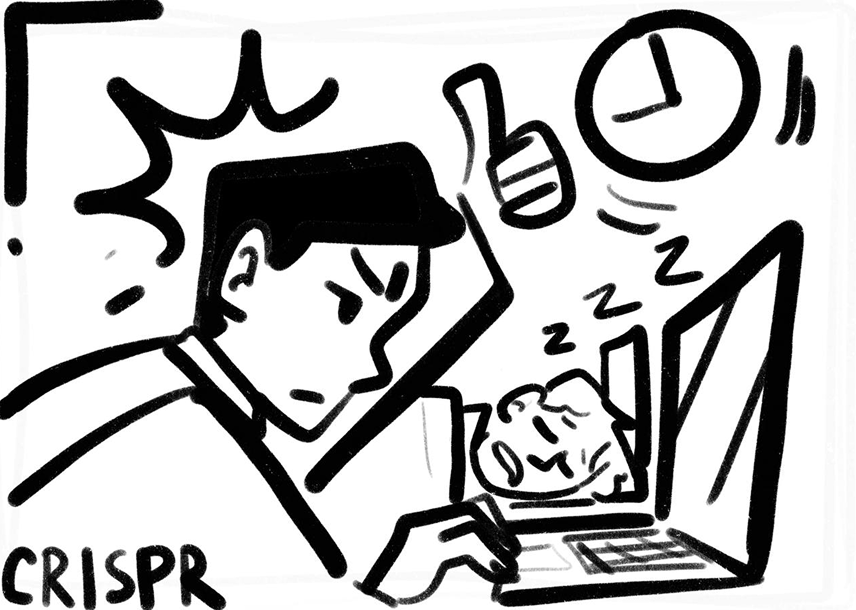Category: Materialization technologies
Genetically modified professionals of the future
Disclaimer. All characters, events, and genetic modifications described in this article are the product of the author’s imagination and the result of reading too many science fiction magazines in one sitting.
Any coincidences with real people, future corporations, or unsuccessful DNA editing experiments are either statistically inevitable accidents or undeniable proof that our editors possess the gift of foresight. In the latter case, please send your resumes to our prophecy service—we are currently looking for talents with a knack for prediction.
Any attempts to reproduce the described genetic modifications in the present year 2025, are strictly discouraged. The editorial team is not responsible for any unintended acquisition of night vision or a sudden craving for Martian apples. Just in case, check if you glow in the dark.
A month ago, a letter was delivered to the editorial office of The Global Technology magazine by a mail carrier. On the envelope, besides the address, there was a note: “Deliver no earlier than 3025 AD.” At first, the editor simply smiled, thinking it was some prankster trying to send mail into the future. But the contents of the dispatched message turned out to be completely unexpected.
We decided to share with you the full text of the letter, including the pencil annotations of Dr. V. Kays, a geneticist expert at NeoBioSys Corporation. We learned his name from the “sender” field, written in the same uneven handwriting as the notes in the document. Whether it’s a joke or not—you decide.
Instruction for HR specialists on hiring genetically modified employees, from November 10, 2065.
1. General Provisions
Modern HR professionals must consider human biotech diversity and manage it during recruitment. Mistakes can cost not only money but also human lives (see the 2062 incident with the overheated thermoresistant strain in the Mars mines).

1.1. Goals and Objectives
This instruction regulates the process of hiring employees with confirmed genetic modifications (GMs) in the context of rapid biotech development and their integration into the employment sector.
Dr. Casey’s note: “People like to pretend they can influence technological development. 40 years ago, they argued about the necessity and ethics of artificial intelligence; now it’s everywhere. For the last 15 years, the expansion of embedded neuro-genetic interfaces in the labor market has been debated. And HR already has its corresponding guidelines…”
Main objectives:
- Ensure ethical and non-discriminatory selection of candidates;
- Consider physiological and cognitive features of GM candidates;
- Comply with the Genetic Equality Law (2049) and the Corporate Bioethics Code.

1.2. Historical Context: How genetic modification became part of HR
Dr. Casey’s note: “A very good point. 80% of HR specialists are too young to remember how turbulent the labor market was after the introduction of digital intelligence. Modern issues seem artificial to them. DNA customization was legalized even before their birth, and it’s now as common as android cleaners.”
Key events that shaped today’s labor market:
After the 2018 scandal with the first CRISPR babies, the international community developed the Global Bioethics Code (2029) to regulate:
- Permissible modification types (medical, professional, corrective);
- Bans on ‘designer children’ (appearance, higher-than-normal intelligence);
- Rights of GM individuals (protection against discrimination, genome confidentiality).

In the 2030s, the first “office gene packs” appeared to boost productivity. Major employers allocated significant funds for employee modifications. The most popular were CRISPR-Caff modifiers, reducing sleep needs from 8 hours to 2 hours, and AdrenaLock, suppressing cortisol release.
Dr. Casey’s note: “Both proved to be extremely negative. The first turned IT specialists into psychopaths in just 3–4 years, and the second caused adrenal crises just as quickly.”
Companies began refusing non-modified candidates, seeking efficiency through GM personnel.
New research and the rise of DNA upgrades in the 2040s led to a wave of DNA augmentations. BioTech corporations started mass-producing targeted modifications for specific professions. Fast career growth via modifications became possible.
Dr. Casey’s note: “And naturally, everyone was eager to get upgrades. Imagine absorbing ten times more information, becoming ten times more charming, stress-resistant, or adaptable to life on Mars. But, for nothing…”
Over time, it was found that many modifications remained unstable. In 2047, over 35% of GM employees required urgent medical aid due to gene correction side effects.
In 2052, the non-modified employees of BioDyne filed a class-action suit for ‘genetic discrimination’ and won. As a result, the global community created the Convention on Genetic Equality:
- Ban on requiring modifications during hiring;
- Mandatory compatibility testing;
- Prohibition on hiring employees with experimental strains.
Current labor market situation:
- 55–60% of applicants have genetic modifications;
- GM personnel are in high demand across industries: especially in high-tech, medicine, space agencies, and security forces.
Dr. Casey’s note: “Ironically, a whole industry has arisen aiming to hire ‘retro-people.’ Their products are often considered elitist precisely because of the ‘naturalness of their employees.'”
2. Recruitment Stages
2.1.
First stage–Genetic Certificate. This document must specify the modification type (medical, professional, experimental), main changes, and restrictions (e.g., enhanced cognition, work restrictions above +40°C). The certificate must be issued by an accredited state center, e.g., GenoSafe.
Dr. Casey’s note: “In 2058, we hired a GM engineer specializing in maintenance with a modification for night vision. An excellent specialist, but he could only work in darkness. Any light turned him into a blind kitten.”
2.2.
Second stage–Testing Tasks. It’s crucial to exclude bias. For example, a candidate with an implanted memory should not receive an advantage in memory tests.
Core principles of adaptation:
- Fairness: tests should evaluate professional skills, not natural or artificial abilities;
- Safety: it’s essential to avoid tasks that could harm individuals with specific modifications;
- Relevance: tests should reflect real job tasks.

See Appendix 1 for detailed methodologies and sample test tasks.
2.3.
Candidates should get approval after going through a medical commission. The relevant points to verify in the form № 093-GM/u:
- Genome stability (>75%);
- Compatibility with corporate bio-implants (>60%);
- Psychological resilience (>80 on the CD-RISC 25 scale).

Dr. Casey’s note: “Psychological resilience is good. But I would also check honesty, greed, stupidity, and laziness. In 2061, we found a GM cook stealing dishes along with food. During the search the police found two pots, four teapots, a dozen of plates, and twelve spoons. As they put it, spoons were found, but the aftertaste remained…”
3. Ethical Norms
Only modifications directly affecting work activities, requiring special working conditions, or posing risks to the team can be discussed.
3.1. HR professionals are forbidden to:
- Copy or share genetic passports;
- Discuss employee modifications with third parties;
- Inquire into personal life, even if related to modifications;
- Compare modifications.
Note: At any moment, an employee or candidate can withdraw consent for genetic data usage.
3.2. Conflict Situations
HR must prevent genetic chauvinism between GM and non-GM staff. Mandatory weekly bioethics training, mentoring programs, and staff rotations are required.
Performance evaluations should be clear and as transparent as possible. It’s necessary to ensure comfortable working conditions for all. It’s recommended to allocate “red zones” for GM employees requiring special conditions (radiation, darkness, high gravity).
Dr. Casey’s note: “In 2055, we hired a sysadmin who worked well in high temperatures. A month later, my wife yelled at me because I suddenly ‘tanned’ perfectly. Turns out, the new employee was absorbing heat and re-emitting it as UV radiation.”

Conflicts are considered solely between employees A and B, without regard to DNA modifications.
4. Benefits and Compensation
4.1. Mandatory Genetic Insurance
All employees with confirmed modifications receive corporate genetic insurance covering:
- Genome stability control;
- Gene expression correction (if modification drift occurs);
- Compatibility checks with corporate biotech tools (if such are applied);
- Sudden degradation of modifications;
- Allergic/autoimmune reactions to environment (conflict with office biomaterials);
- Unexpected mutations needing urgent correction.

Insurance does not cover voluntary modifications made after employment without company notification. Employees must report changes to their genetic status promptly.
4.1. Working Conditions and Additional Guarantees for GM Staff
4.2.1. Specialized Nutrition and Environment
- High-metabolism employees must be given free, high-calorie diets (5–7 times a day);
- Employees with altered biochemistry should have access to personalized vitamin complexes.
4.2.2. Flexible Schedule and Working Modes
It’s important to provide personalized schedules for employees with atypical biorhythms, including “micro-sleeps” (15–20 min every 4 hours) for hyperphase modifications.
Corporate Upgrades Program
Funding for significant professional modifications is available for employees with more than 2 years of working experience.
Conditions:
- Voluntary participation;
- Full transparency of risks and consequences;
- 3-year employment moratorium post-procedure;
- Co-financing for costly modifications.
The full list of available upgrades is updated quarterly and approved by the bioethics committee.
It is strictly forbidden to compel staff to modify DNA under threat of dismissal, require participation in experimental programs, or pay less to non-GM staff.
Dr. Casey’s note: “At the dawn of DNA customization, Professor Grachyov forced all staff to install an ‘anti-alcohol’ modification. It turned out this modification also blocked caffeine. The lab turned into a sleepy kingdom—the professor was fired, and now he consults Starbucks.”
5. Termination of GM Employees: Special Procedures and Guarantees
5.1. Grounds for dismissal:
- Staff reduction;
- Mismatch with job role;
- Disciplinary violations.
5.2. Specific grounds:
- Instability of genetic modifications posing threat to the working process;
- Expiry of licenses for certain modifications;
- Medical contraindications caused by working conditions.
5.3. Dispute Resolution:
- Mandatory pre-trial settlement through a mediator;
- Right to independent genetic expertise;
- Possibility of getting your position back with adjusted conditions.
Note: When an employee resigns, the company must provide comprehensive information on potential consequences for their modifications.
Conclusion
In a world of widespread gene editing, HR tasks remain the same: recruiting, training and developing the personnel, evaluating and motivating, productivity management, as well as maintaining corporate culture. We must consider GM-specific features and utilize them for the maximum benefit for the company, without disadvantaging non-GM personnel.
Document valid as of 2065. Approved by the Genetic Ethical Committee.
Dr. Casey’s note: “If our communications department is right (and these guys have eight mods for cognitive abilities), you’re reading this from the year 3025, and what you see are just events from the distant future. I am sure it will seem a little bit frightening to you, but rest assured, humans remain humans—even if they’re green and glow in the dark. When you see our apple orchards on Mars you’ll understand that it was worth it. Sincerely yours, Viktor Casey.”
Your thought is a big bang of ideas. Our journal is its source.
Thank you!




